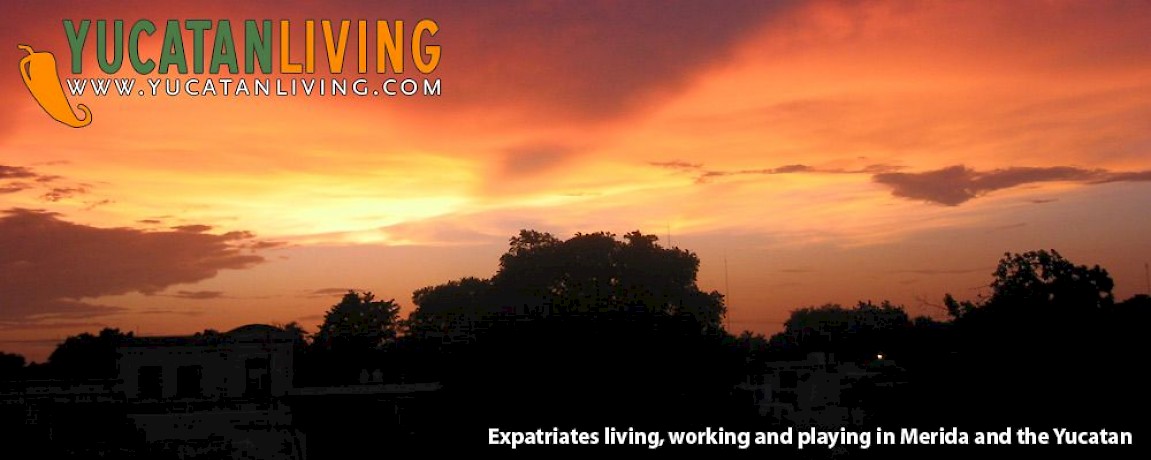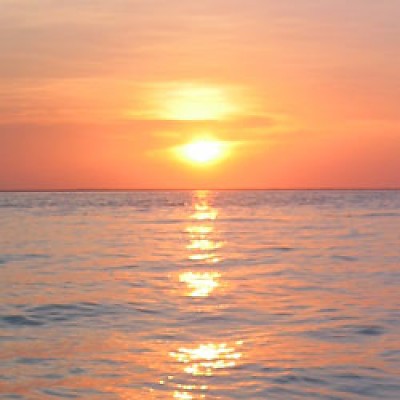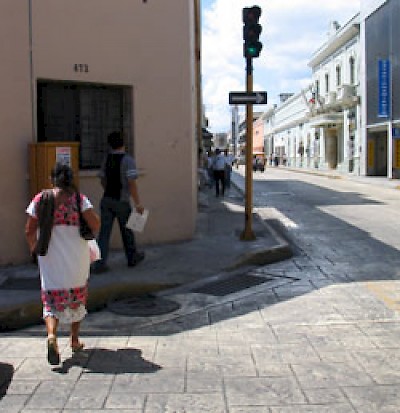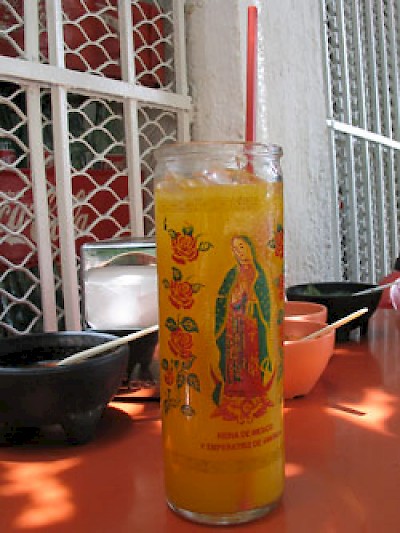Hay Calor!
For the past few days, the temperature here in Merida has soared and we are suddenly drinking a lot more water and Gatorade. It seems like only last week when it was a comfortable 80 degrees. Well, it really *was* only last week. The seasons turn quickly here, and this sudden change of weather tells us we're about to pay for our paradise with a little hay calor! (it’s hot!) Or if you prefer the Mayan: choco kin!
It doesn't confuse us anymore that in Mexico, as in most of the world, they report the temperature in Centigrade, which means it’s "only" 40 degrees right now. We now know that 40 degrees means a walk outside puts us in danger of heat exhaustion, but for the sake of our US audience we'll speak in Fahrenheit for the remainder of this article.
The Yucatan has four seasons, just like everyone else, but they are not very different. In fact, they are variations on only two themes: temperature and humidity.
Spring: hot and dry
Summer: hot and wet
Fall: cool and wet
Winter: cool and dry
Of course, the word “cool” is relative. We'll define cool to mean that the day's high temperature is below 90 degrees. We've seen a few days in January when the temperature dipped into the 50's at night and never rose above 70 during the day. There are several weeks during the winter months when you'll want a light coat or sweater. But in general, the cool days are still tropical, so shorts and a t-shirt in public and a sarong at home work for us.
Hot is also a relative term. The highest average temperature in Merida - usually recorded in May - is 97 degrees and it seldom goes higher than 105. Sounds hot enough, right? Well, there are places where we come from where the temperature can exceed a scorching 120 degrees. On paper, that makes Merida look a bit less punishing, but as anyone from the southwestern part of the United States will remind you: “…it’s dry heat.” Here in Yucatan, we have a different reminder: “it’s not the heat, it's the humidity.”
We're really tickled by the temperature report on weather.com when it says something like:
Merida
Temperature: 89
Feels Like: 104
What it should say is, “Feels Like: You're a Poached Egg”.
Humidity - Mother Nature’s warm, wet embrace – traps the heat in your body and raises your “core temperature”, which makes staying cool the first priority of living in the Yucatan.
Almost every aspect of Yucatan life - cultural, social and even architectural - is informed and influenced by the tropical climate. The traditional Mayan dress code is light, white cotton fabric, with panama style hats for men and a rebozo, or shawl, for the women. Surprisingly, you’ll seldom see locals wearing shorts or going shirtless; they prefer to keep their bodies covered. The main reason for this, we’ve observed, is to prevent a cool breeze, called a fresca, from sending a chill over clammy skin. This effect can cause muscle cramps and many believe it causes illness as well. When you are in a crowd in the Yucatan during the heat, you'll notice the distinct odor of baby powder. In this heat, baby powder is for everyone because it really does reduce the stickiness caused by such intense humid heat.
The Spanish tradition of siesta is popular in many parts of Mexico, and certainly here in Yucatan. The hottest part of the day is generally between the hours of 2:00 and 4:00 pm when it makes a lot of sense to stay indoors and rest, rather than court heat exhaustion. Most Yucatecos start their day rather early, often before sunrise, so they can eat breakfast and do their morning chores in the cool, early hours. The business day starts at 8:30 am and winds down by 2:00 pm. After lunch and a siesta, business picks back up and the formal day ends around sunset. The traditional dinner hour begins at 10:00 pm, and if you’re a real local, you may be chatting with friends or dancing salsa until 1:00 am or later. This lifestyle offers two days in one, with the majority of your social life spent during the coolest parts of the day. You don’t have to live here long to assimilate. In fact, it's harder not to.
One of the many charming features of Yucatan social life can be seen everywhere, from the smallest pueblos to the urban center of Merida, the largest city. After dark, entire families will tote any form of seating that may be handy outside their front doors so they can share the events of their day in cool, evening frescas. Passersby are obliged to walk through these impromptu living rooms, offering a polite “buenas noches” to the adults, an admiring smile for the children and a pat for the dog.
Tall and often ornate Spanish colonial facades line the streets of the historical centers of Yucatan's cities such as Merida, Izamal and Valladolid. This creates a somewhat canyon-like feel when walking between them, but can also offer an opportunity to beat the heat. With the exception of high noon, one side of the street is in shade and the other in sunlight. We call these the Yucateco side and the Gringo side, respectively. Locals instinctively choose the cooler but more crowded shady side, while tourists choose the less populated sun-drenched side and arrive at their destination sunburned and dehydrated.
One of the first Spanish words we learned after moving here was “tranquilo”, which has many uses, but generally means “relax, take it easy”. There’s a lot of wisdom in this word (in many different contexts) but the most noticeable one is that Yucatecos move slowly. There is no "hustle" in Yucatan. If you stride rapidly down the street as if you are in New York, your “core temperature” rises and you blithely melt into the pavement.
The architecture of Yucatan’s colonial homes is well adapted to the climate. Behind those tall facades are equally tall ceilings, often 18 to 25 feet above the tiled floors. As the heat of the day rises, it collects near the ceiling, while the tiles maintain a cooler atmosphere below. Add ceiling fans for circulation, thick limestone walls and a central patio for drawing fresh air into the surrounding rooms. The result is an ambiance somewhat like a wine cellar.
Despite their resemblance to mansions found in Europe and other colonial parts of Latin America, there is one thing you’ll never see in a colonial home in Merida: a fireplace.
But you will find something you’ll seldom see elsewhere: the hammock. This bit of Yucatan “furniture” is more popular here than sleeping on a mattress or sitting in an upholstered chair. Besides taking up less space (they can be easily stowed during the day), hammocks ventilate the entire body. On warm, sultry nights, sleeping in a hammock under a ceiling fan is a more pleasant experience than tossing and turning on a humid mattress. And nothing beats a hammock for a mid-day siesta.
Of course, the same modern technology that made such exotic destinations as Las Vegas and Miami safe for habitation is widely used here, namely air conditioning. These systems are usually “split” units, with the condenser located on the roof and the ventilator hung high on an interior wall. Most colonial homes are too large to fully air condition in this way, so you usually find them only in bedrooms. During summer, the operating costs of keeping cool at home can exceed $200 per month in electric bills.
Since many of the locals can’t afford to air condition their homes, they seek it out in other venues. On a particularly hot day, you’ll find that the large grocery chains, the shopping malls and especially the cineplex are packed with crowds who are there for the same reason others go to the beach.
Another option is to visit a local cenote, which is an opening in the limestone that exposes the aquifer underneath. The Yucatan Peninsula is dotted with hundreds of them. Some are on the surface, some in grottos and others hidden in caves. The water is cool, clear and usually around 72 degrees, which makes for a very refreshing swim.
There is a tradition in Merida that probably dates back to the ancient Maya. Every July and August, everyone takes off for the coast. Most go north to the Gulf of Mexico where a reliable trade wind blows from offshore, the same one that brought the Spanish conquerors from Europe. People rent the beach houses that North American “snowbirds” use during winter. Family and friends are invited. Spontaneous nighttime fiestas are celebrated on the streets and malecon, with seafood, music and plenty of cold cerveza.
A tropical environment like the Yucatan is for people who enjoy activities for cooling off. If you prefer to cuddle by the fireplace with the hush of snowfall outside your window… well, you might want to look elsewhere. On the other hand, if you like a dip in the pool and a cold drink while perfecting your tan, then you’re in the right place.
One last important linguistic note: there are (at least) three words in Spanish for “hot”. They are picante, caliente and calor. Gringos tend to confuse these. Picante, which comes from the verb picar (to sting) refers to anything spicy. Chiles and salsa are picante. Caliente generally involves fire. When you heat water it is caliente. Caliente also has the same sexual connotations as “hot” in English. A hotdog, literally translated, means a dog that is in heat. Calor refers to the weather.
These distinctions get blurred a bit. If it’s hot outside (calor) and it makes you feel hot, then when referring to yourself, use caliente, because you have been heated. The real trouble occurs with the difference between the English and Spanish use of “be” and “have”. If you say “estoy caliente” (I am hot), then you are confessing to being sexually aroused. You must instead say “tengo caliente” (I have hot). Although body language often helps clear up any misunderstandings, in neither case does it help to pant with your tongue hanging out.
Although it's unlikely you'd ever need to here, never use the expression, “estoy frio” (literally, I am cold). This means you are dead.











Comments
Sherry 19 years ago
Muchas gracias, Gringos, for your list of suggestions of must-see/do!! I cannot wait -- I do my own little happy dance at least twice a day just thinking about my upcoming trip to Merida. (My kids think I'm nuts.)
I will definitely keep in touch.
Speaking of which...I've never done it before, but I'm considering creating a blog (complete with photos) specifically to share my trip with close friends and relatives. Can you suggest a blog host that is user-friendly for a blogger novice?
Thanks!
Reply
manuelito 19 years ago
hey i forgot to answer this one,well let me tell you this here in us i always move around,i've been in a few cities on the west side,but my last trip(scape) from work was to wyoming (yellowstone national park),it was awesome,unbelievable,i am going back,i have to save a little bite of money first but i will sometime this year,today i live in a friend's house(they let me use the computer),but usually i am anywhere in the west.i think i am going back to denver soon but i am not sure yet we'll see what happens.see ya!! that's why i wrote down from the heat to the ice..yellowstone on the winter is dang cold!!!!
Reply
Kent Swanson 19 years ago
Just discover this very cool website about the Yucatan. It’s for both tourists and for those interested in living in this beautiful and culturally rich part of Mexico. Check it out!
Reply
Working Gringos 19 years ago
Oye, Manuelito! Muchisimas gracias! That's a great link you found for the farias in the pueblitos. Hopefully we can go to the one this weekend in Progreso. We doubt there will be a corrida, but there will probably be a carnaval and circus and a lot about fishing, but vamos a ver.
We do know about the Feria Yucatán in X´matkuil (ish MAHT kool eel). And, yes, we've been to Las Grutas de Loltun. They are lovely. We've also done somewhat more adventurous spelunking (look it up) at Calcehtok. Ever heard of it?
Hey, where are you that there is still ice? Pobrecito!
Nos vemos!
Reply
manuelito 19 years ago
ya lo encontre!!! i found it!!!, i found it!! geez it took me a lot of time because i do not have a lot of good computer skills,but here it is,i found this first page this one is from the yucatan fair, http://www.feriayucatan.com, this one is sometime in november and this other page has a lot of dates for the fairs in the little and medium towns in yucatan but is in spanish i hope u guys can understand it, http://www.travelbymexico.com/merida/ferias/index.html well i hope this helps, hey thanks for making me feel like i am very close to merida, i hope to be there pretty soon maybe 1 more year or so, hope u guys r enjoying yucatan, i do not know if u guys heard abut this place yet: GRUTAS DE LOLTUN, it is located close to uxmal. its a cave and is awesome. check that out. u guys will love it. well that is all for now bye guys. p.s from the heat to the ice.
Reply
manuelito 19 years ago
hello!i just came back for a 5 days trip, working of course. hey i do not know the date of the fairs but i think i can look up these days and as soon as i know,you'll know ok? well i just want you to know that i couldn't read these lines for me because i wasn't here, but thanks for answering me hasta luego
!!!
Reply
Jeremy Brett 19 years ago
Fantastic website! I visited Mérida for 3 days in December 2004 and fell in love with many of the things you blog about, most notably the incredible people. I'm hoping to spend this July there studying, and your entries are giving me a great overview of what to expect during an extended stay.
Cheers,
Jeremy
Asheville, NC
Reply
Working Gringos 19 years ago
Que bueno, Sherry, gracias! You should have a great time. Wish we could join you. Learning another language is a life-long process, and when it comes to Spanish, we're about four years old. Actually, we've overheard real four-year-olds who speak it better than we do.
You'll have plenty to do here. There is a list of usual suspects below, but don't pass up the opportunity to just float around the historical center and some of the neighborhood parks to see what happens, meet people and practice your Spanish. Be sure to hang out on Sundays in the main plaza (Domingos en Merida), Thursday evenings at Santa Lucia park (Las Serenadas), Saturday evenings at the south end of the Paseo de Montejo at calle 47 (Noche Mexicana) and Friday evenings in the centro (En El Corazon de Merida). These are long-running cultural events sponsored by the city. You might also enjoy a concert at the bella epoca-style Teatro Peon Contreras on Calle 62. Friday and Sunday shows are free. For more information about these events and the stuff below, you can Google them.
A list of things to see while staying in Merida:
1. Chichen Itza: a full day excursion to the most famous Mayan archaeological zone is a must do.
2. Uxmal: the second most famous Mayan zone, and we think the most beautiful.
3. Merida Mercado: you haven't immersed until you've been here.
4. Hacienda Temozon: go early, have breakfast, learn about the history of the haciendas in Yucatan.
5. Izamal: the yellow city built on Mayan ruins and home to the important Mayan prophet Itzam'na.
6. Celestun: biological reserve on the Gulf of Mexico, with a boat ride through mangroves to see the flamingos. End the day with a plate of ceviche.
7. Castro Pacheco murals: in the Governor's Palace on the main plaza.
8. Merida House and Garden Tour: you'll be amazed at what you find inside these old colonial homes.
9. Weekend in Tulum: our favorite piece of Caribbean paradise and the location of the third most important Mayan archaeological zone.
10: Gran Plaza: just a big shopping mall, but a good way to see hip Yucatecos behaving like Norte Americanos. It helps you ease back into the modern world before your return to the States. Buy a t-shirt at Mayan Xic and drop crumbs on it at Kukis.
Nos vemos!
Reply
Sherry 19 years ago
I have enjoyed your blog since I first discovered it about weeks ago.
This summer I will be studying Spanish in one of the Spanish language schools there. I'm from Chicago and have never been out of the country -- so I'm really looking forward to this experience!
What advice can you offer about excursions or "must-sees" in Merida. What are your suggestions for making the most of my immersion experience?
Reply
Working Gringos 19 years ago
Hola, Manuelito! We would love to go to a Fieste del Pueblo and write about it (and take photos). The problem is we never know exactly when one is. Do you have a favorite pueblo that you remember? Do you remember when the fiesta is? If you have a specific place and time in mind, we'll try to go for you and tell you all about it!
Reply
manuelito 19 years ago
"se esta poniendo caluroso" it means something like it's gettin' warm,and "se esta poniendo caliente" it means it's gettin' hot,and all these sentences they refer to the weather,only a remark in the first sentence it has an "U"instead an "O",well all i have to say is that,i think u guys should talk about the FIESTA DEL PUEBLO,it means something like TOWN FAIR,it is really hard for me to find an exactly word for the translation cos i only have like 4 years speaking,writting and reading english and it is really hard for me but ask around it is a fair in every single town in yucatan,with fireworks,and FOOD!!!!!!!!,beer,and a lots of fun with "corridas de toros",i hope u guys have the time to go out and be there and talk about it later that'll be awesome,well that,s all i have to say for now. stay cool and have fun.
Reply
« Back (20 to 31 comments)Next »